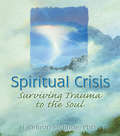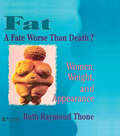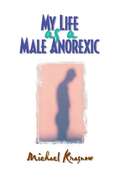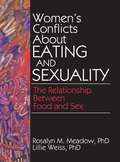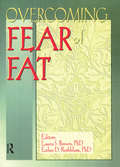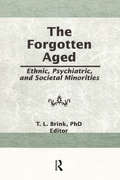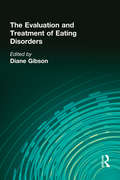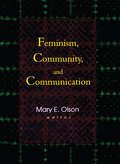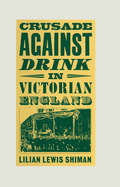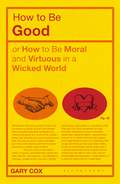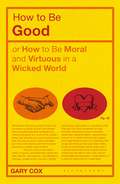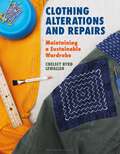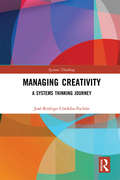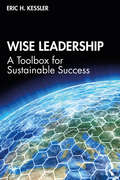- Table View
- List View
Spiritual Crisis: Surviving Trauma to the Soul
by J Lebron McbrideIt’s no revelation that in today’s world many people suffer from some form of spiritual crisis. But, fortunately, there is hope. In Spiritual Crisis: Surviving Trauma to the Soul, you’ll discover how you can reverse the impact of spiritual crisis and apply healing balm to the traumatized soul. A comprehensive, real-life approach to spiritual care, it gives you the understanding necessary to put a lid on the daily chaos that seeks to destroy those whose lives have been shattered by tragedy, terror, and disillusionment.Written from the perspective of a compassionate professional who has navigated the dark and turbulent waters of his own spiritual crises, Spiritual Crisis represents a loving cross-section of aid from the fields of pastoral theology, psychology, and health care. Christians and non-Christians alike will benefit from its frank approach to aiding troubled souls through the tough times of belief transition, loss of faith, and potentially damaging extremes in living and thinking. Specifically, you’ll read about: understanding the effects and roots of spiritual crisis and trauma coping with loss counteracting disillusionment with the church negotiating belief transitions dealing with religious burnout intervening in denominational identity crisesOftentimes, it’s hard to know what will make a loved one survive or succumb to the impact of seemingly insurmountable personal emergencies. However, this book is a “call to care” that will enable you to help others turn back the tide of debilitating hardship in their lives and restore the tempering unity of mind and body. Whether you’re a beginning pastoral counselor, a marriage and family therapist, or friend of a troubled loved one, Spiritual Crisis will show you and those you work with how to turn crisis into care.
Spiritual Crisis: Surviving Trauma to the Soul
by J Lebron McbrideIt’s no revelation that in today’s world many people suffer from some form of spiritual crisis. But, fortunately, there is hope. In Spiritual Crisis: Surviving Trauma to the Soul, you’ll discover how you can reverse the impact of spiritual crisis and apply healing balm to the traumatized soul. A comprehensive, real-life approach to spiritual care, it gives you the understanding necessary to put a lid on the daily chaos that seeks to destroy those whose lives have been shattered by tragedy, terror, and disillusionment.Written from the perspective of a compassionate professional who has navigated the dark and turbulent waters of his own spiritual crises, Spiritual Crisis represents a loving cross-section of aid from the fields of pastoral theology, psychology, and health care. Christians and non-Christians alike will benefit from its frank approach to aiding troubled souls through the tough times of belief transition, loss of faith, and potentially damaging extremes in living and thinking. Specifically, you’ll read about: understanding the effects and roots of spiritual crisis and trauma coping with loss counteracting disillusionment with the church negotiating belief transitions dealing with religious burnout intervening in denominational identity crisesOftentimes, it’s hard to know what will make a loved one survive or succumb to the impact of seemingly insurmountable personal emergencies. However, this book is a “call to care” that will enable you to help others turn back the tide of debilitating hardship in their lives and restore the tempering unity of mind and body. Whether you’re a beginning pastoral counselor, a marriage and family therapist, or friend of a troubled loved one, Spiritual Crisis will show you and those you work with how to turn crisis into care.
Fat - A Fate Worse Than Death?: Women, Weight, and Appearance
by Ellen Cole Esther D Rothblum Ruth R ThoneDespite the gains of the women’s movement, women are still judged by what they look like--and men, by what they do. Fat--A Fate Worse Than Death? offers hardy resistance to the narrow, random, and irrational appearance standards set for American women through an approach that is personal, eclectic, courageous, and funny. If you are interested in giving up your diet, throwing out your scales, and concentrating on who you are on a deeper level, this book will show you how to accept, appreciate, and even love your body!Using statistics, research, anecdotes, and personal experiences, Fat--A Fate Worse Than Death? explores how appearance standards have built a prison for women. With the book’s helpful advice, reading suggestions, and list of more than 100 ways to fight looksism, sexism, ageism, and racism, you will learn to express your rights and needs, regardless of your shape or size, and tear down those prison walls. Designed to transcend the boundaries between the personal and the political, Fat--A Fate Worse Than Death? discusses: examples of how weight and size constitute the last socially accepted prejudice the national “War on Fat” counteracting societal influences that support weight preoccupation connection between appearance standards for older women and large women nurturing your body resisting male-defined standards of beauty for women the myth of diets and dieting how the body resists weight loss how women are disempowered by concentration on weight and appearance how concentrating on appearance leaves real-life issues unaddressed how feeling bad about yourself can turn you into a willing consumerFeminists, faculty and students of women’s studies programs, aging women, women of radical politics, and other concerned women and men will find that Fat--A Fate Worse Than Death? states explicitly how women are kept powerless by subscribing to cultural and social edicts on physical appearance. Don’t live silently in a society that degrades and discounts women because of their physical stature and don‘t let obsession with thinness keep you passive, docile, and unable to give your energy to things that really need your passion and intelligence. Read this book and learn to not only value yourself for who you are, but also to counteract American culture’s equality-denying prejudices and practices.
Fat - A Fate Worse Than Death?: Women, Weight, and Appearance
by Ellen Cole Esther D Rothblum Ruth R ThoneDespite the gains of the women’s movement, women are still judged by what they look like--and men, by what they do. Fat--A Fate Worse Than Death? offers hardy resistance to the narrow, random, and irrational appearance standards set for American women through an approach that is personal, eclectic, courageous, and funny. If you are interested in giving up your diet, throwing out your scales, and concentrating on who you are on a deeper level, this book will show you how to accept, appreciate, and even love your body!Using statistics, research, anecdotes, and personal experiences, Fat--A Fate Worse Than Death? explores how appearance standards have built a prison for women. With the book’s helpful advice, reading suggestions, and list of more than 100 ways to fight looksism, sexism, ageism, and racism, you will learn to express your rights and needs, regardless of your shape or size, and tear down those prison walls. Designed to transcend the boundaries between the personal and the political, Fat--A Fate Worse Than Death? discusses: examples of how weight and size constitute the last socially accepted prejudice the national “War on Fat” counteracting societal influences that support weight preoccupation connection between appearance standards for older women and large women nurturing your body resisting male-defined standards of beauty for women the myth of diets and dieting how the body resists weight loss how women are disempowered by concentration on weight and appearance how concentrating on appearance leaves real-life issues unaddressed how feeling bad about yourself can turn you into a willing consumerFeminists, faculty and students of women’s studies programs, aging women, women of radical politics, and other concerned women and men will find that Fat--A Fate Worse Than Death? states explicitly how women are kept powerless by subscribing to cultural and social edicts on physical appearance. Don’t live silently in a society that degrades and discounts women because of their physical stature and don‘t let obsession with thinness keep you passive, docile, and unable to give your energy to things that really need your passion and intelligence. Read this book and learn to not only value yourself for who you are, but also to counteract American culture’s equality-denying prejudices and practices.
My Life as a Male Anorexic
by Michael KrasnowMy Life as a Male Anorexic is a uniquely male point of view of anorexia nervosa. It is the autobiographical account of a young man’s ongoing struggle with anorexia. Michael shared his story as part of the featured health segment “Men Dying to be Thin” on WSVN Channel 7 News in Miami, Florida, in May 1997.Michael Krasnow has had anorexia since 1984, and he chronicles his daily struggles, feelings, and experiences in this book. He writes in a relaxed, easygoing manner that makes the book appealing to all readers. While ignoring statistics and not pretending to be an expert on the disorder, Michael simply tells readers what his life is like and how anorexia has affected--even controlled--it. As of today, Michael has maintained his weight at 75 pounds on a 5-foot, 9-inch frame.Anyone who suffers, or anyone who knows someone who suffers from, anorexia will learn that male anorexia is a serious problem and that there needs to be psychological and medical help for the boys and men who struggle with anorexia. As Michael begins his book, “For years, anorexia existed, but very few people knew of it. Women who suffered from it did not realize that they were not alone. Eventually, as more became known and anorexia became more publicized, a greater number of women came forward to seek help, no longer feeling that they would be considered strange or outcasts from society. Maybe with the publication of this book, more men with the problem will realize that they are not alone either, and that they do not suffer from a ‘woman’s disease.’They can come forward without worrying about embarrassment.”Michael’s story will baffle, frustrate, sadden, and irritate readers, whether they are interested in the human side of Michael’s story, whether they are workers in the medical field--psychologists, psychiatrists, doctors, nurses, aides, social workers, mental health counselors--or whether they are teachers, coworkers, friends, or relatives of a male with anorexia. My Life as a Male Anorexic begins to shed light on the little-known or discussed problem of male anorexia nervosa.
My Life as a Male Anorexic
by Michael KrasnowMy Life as a Male Anorexic is a uniquely male point of view of anorexia nervosa. It is the autobiographical account of a young man’s ongoing struggle with anorexia. Michael shared his story as part of the featured health segment “Men Dying to be Thin” on WSVN Channel 7 News in Miami, Florida, in May 1997.Michael Krasnow has had anorexia since 1984, and he chronicles his daily struggles, feelings, and experiences in this book. He writes in a relaxed, easygoing manner that makes the book appealing to all readers. While ignoring statistics and not pretending to be an expert on the disorder, Michael simply tells readers what his life is like and how anorexia has affected--even controlled--it. As of today, Michael has maintained his weight at 75 pounds on a 5-foot, 9-inch frame.Anyone who suffers, or anyone who knows someone who suffers from, anorexia will learn that male anorexia is a serious problem and that there needs to be psychological and medical help for the boys and men who struggle with anorexia. As Michael begins his book, “For years, anorexia existed, but very few people knew of it. Women who suffered from it did not realize that they were not alone. Eventually, as more became known and anorexia became more publicized, a greater number of women came forward to seek help, no longer feeling that they would be considered strange or outcasts from society. Maybe with the publication of this book, more men with the problem will realize that they are not alone either, and that they do not suffer from a ‘woman’s disease.’They can come forward without worrying about embarrassment.”Michael’s story will baffle, frustrate, sadden, and irritate readers, whether they are interested in the human side of Michael’s story, whether they are workers in the medical field--psychologists, psychiatrists, doctors, nurses, aides, social workers, mental health counselors--or whether they are teachers, coworkers, friends, or relatives of a male with anorexia. My Life as a Male Anorexic begins to shed light on the little-known or discussed problem of male anorexia nervosa.
Women's Conflicts About Eating and Sexuality: The Relationship Between Food and Sex
by Ellen Cole Esther D Rothblum Lillie Weiss Rosalyn MeadowWomen’s Conflicts About Eating and Sexuality explores the strong relationships food and sex have represented to women over the years. No other book has spelled out so clearly the parallels between sex and eating nor integrated the relationship of these to women’s basic need to be loved. Today’s dilemma for women--be fat or go hungry--and the endless variations and unsatisfying solutions to this problem have contributed to the incidence of anorexia, bulimia, and obesity. The pursuit of slimness, the obsession with having the perfect body, excessive aerobicizing, and diet books ad nauseam are all part of this phenomenon. Authors in Women’s Conflicts About Eating and Sexuality skillfully discuss the parallel between women’s obsession with sex and romance in the fifties and their obsession with food today. An important book for all women, it sheds light on the complex issues facing women and devotes special attention to the career woman and the additional pressures to be slim and stay slim. The woman who reads this potentially life-changing book can examine, question, and change her behavior, using the specific step-by-step program aid included in the book. This book is for every woman who has ever worried about being too fat or too sexual. Women’s Conflicts About Eating and Sexuality will appeal to women of all ages--young women and their mothers will be fascinated by the parallels between sexual obsessions of thirty years ago and the eating obsessions of today. This healing book will particularly attract single career women for whom sex and relationships are fraught with complications. Counselors and therapists will find this book an excellent resource in their work with helping women. It is also a good auxiliary text for courses in Women’s Studies focusing on psychology and history of women and the sociology of women and eating disorders.
Women's Conflicts About Eating and Sexuality: The Relationship Between Food and Sex
by Ellen Cole Esther D Rothblum Lillie Weiss Rosalyn MeadowWomen’s Conflicts About Eating and Sexuality explores the strong relationships food and sex have represented to women over the years. No other book has spelled out so clearly the parallels between sex and eating nor integrated the relationship of these to women’s basic need to be loved. Today’s dilemma for women--be fat or go hungry--and the endless variations and unsatisfying solutions to this problem have contributed to the incidence of anorexia, bulimia, and obesity. The pursuit of slimness, the obsession with having the perfect body, excessive aerobicizing, and diet books ad nauseam are all part of this phenomenon. Authors in Women’s Conflicts About Eating and Sexuality skillfully discuss the parallel between women’s obsession with sex and romance in the fifties and their obsession with food today. An important book for all women, it sheds light on the complex issues facing women and devotes special attention to the career woman and the additional pressures to be slim and stay slim. The woman who reads this potentially life-changing book can examine, question, and change her behavior, using the specific step-by-step program aid included in the book. This book is for every woman who has ever worried about being too fat or too sexual. Women’s Conflicts About Eating and Sexuality will appeal to women of all ages--young women and their mothers will be fascinated by the parallels between sexual obsessions of thirty years ago and the eating obsessions of today. This healing book will particularly attract single career women for whom sex and relationships are fraught with complications. Counselors and therapists will find this book an excellent resource in their work with helping women. It is also a good auxiliary text for courses in Women’s Studies focusing on psychology and history of women and the sociology of women and eating disorders.
Overcoming Fear of Fat
by Esther D Rothblum Laura BrownHere is an enlightening new volume that presents an integration of anti-fat-oppressive attitudes into the work of feminist therapy. Overcoming Fear of Fat is unique among professional work in the area of women and fat in that it does not approach size as the problem; rather it approaches prejudice against fat as the problem. Although for nearly a decade, fat activists have been raising the issues that are confronted in this book, therapists, including feminist therapists, have been colluding with their clients in pathologizing fat, celebrating weight loss, and failing to adequately challenge cultural stereotypes of attractiveness for women, instead of empowering clients and encouraging them to take on expert authority about their own experiences. The contributors, including therapists and fat activists, aim to disconnect the issues of food intake and eating disorders from those of weight. They share personal and professional experiences of challenging fat oppression, offer strategies for therapists to rid themselves and their clients of fat oppressive attitudes, and most importantly, they confront long-held cultural myths that fat is unhealthy, and that fat women are physically unfit and are in hiding from their sexuality or personal power. A practical and informative resource for therapists, especially those who work with fat women or who themselves struggle with issues of feeling critical of their own body size, Overcoming Fear of Fat will also be a valuable guide for fat women who wish to feel supported in their struggle for self-worth and respect.
Overcoming Fear of Fat
by Esther D Rothblum Laura BrownHere is an enlightening new volume that presents an integration of anti-fat-oppressive attitudes into the work of feminist therapy. Overcoming Fear of Fat is unique among professional work in the area of women and fat in that it does not approach size as the problem; rather it approaches prejudice against fat as the problem. Although for nearly a decade, fat activists have been raising the issues that are confronted in this book, therapists, including feminist therapists, have been colluding with their clients in pathologizing fat, celebrating weight loss, and failing to adequately challenge cultural stereotypes of attractiveness for women, instead of empowering clients and encouraging them to take on expert authority about their own experiences. The contributors, including therapists and fat activists, aim to disconnect the issues of food intake and eating disorders from those of weight. They share personal and professional experiences of challenging fat oppression, offer strategies for therapists to rid themselves and their clients of fat oppressive attitudes, and most importantly, they confront long-held cultural myths that fat is unhealthy, and that fat women are physically unfit and are in hiding from their sexuality or personal power. A practical and informative resource for therapists, especially those who work with fat women or who themselves struggle with issues of feeling critical of their own body size, Overcoming Fear of Fat will also be a valuable guide for fat women who wish to feel supported in their struggle for self-worth and respect.
The Forgotten Aged: Ethnic, Psychiatric, and Societal Minorities
by T.L. BrinkThis helpful book explores mental health issues relating to elders who do not fit into the “usual” mold for research--white, married or widowed, urban or suburban persons with adult children. The Forgotten Aged focuses on those groups of elders often overlooked in gerontological literature--elder African-Americans, rural aged, gay and lesbian aged, parents of developmentally disabled offspring, older developmentally disabled persons themselves, and “orphan” elders (those who do not have close family members who can serve as caretakers). The book offers “how to” advice on issues such as outreach, intervention, residential placement and transition, assessment, psychotherapy, and team building to help readers learn effective ways of helping elderly persons from these various groups. With an optimistic tone, it explores how more attention and resources, combined with flexible modifications of programs and practices, can yield favorable results for everyone involved. In The Forgotten Aged, authors examine a variety of pertinent topics including: assessment of dementia and depression in African-Americans multidisciplinary team outreach to elderly living in rural areas therapeutic issues with gay and lesbian aged residential transitions for developmentally disabled elderly helping aging parents of developmentally disabled offspring intervention with “orphan” elderly with Alzheimer’s diseaseSocial workers, psychologists, psychiatrists, geriatricians, nurses, and counselors involved in providing support and care for elderly persons will find The Forgotten Aged a useful guide in their daily work and decisionmaking. This book can also serve as an enlightening supplementary text in courses that study aging and the elderly.
The Forgotten Aged: Ethnic, Psychiatric, and Societal Minorities
by T.L. BrinkThis helpful book explores mental health issues relating to elders who do not fit into the “usual” mold for research--white, married or widowed, urban or suburban persons with adult children. The Forgotten Aged focuses on those groups of elders often overlooked in gerontological literature--elder African-Americans, rural aged, gay and lesbian aged, parents of developmentally disabled offspring, older developmentally disabled persons themselves, and “orphan” elders (those who do not have close family members who can serve as caretakers). The book offers “how to” advice on issues such as outreach, intervention, residential placement and transition, assessment, psychotherapy, and team building to help readers learn effective ways of helping elderly persons from these various groups. With an optimistic tone, it explores how more attention and resources, combined with flexible modifications of programs and practices, can yield favorable results for everyone involved. In The Forgotten Aged, authors examine a variety of pertinent topics including: assessment of dementia and depression in African-Americans multidisciplinary team outreach to elderly living in rural areas therapeutic issues with gay and lesbian aged residential transitions for developmentally disabled elderly helping aging parents of developmentally disabled offspring intervention with “orphan” elderly with Alzheimer’s diseaseSocial workers, psychologists, psychiatrists, geriatricians, nurses, and counselors involved in providing support and care for elderly persons will find The Forgotten Aged a useful guide in their daily work and decisionmaking. This book can also serve as an enlightening supplementary text in courses that study aging and the elderly.
The Evaluation and Treatment of Eating Disorders
by Diane GibsonThis important volume addresses a growing problem prevalent in hospitalized patients--eating disorders, including anorexia nervosa and bulimia. Experts present the latest findings on the theories, evaluation, and treatment of this pernicious syndrome. Clearly written and up-to-the-minute, this outstanding collection of interdisciplinary vantage points, overlapping theories, and program applications will be of great value to front-line clinicians. Also included are historical perspectives, the treatment and rehabilitation of eating disorders, characteristics of families with eating disorders, and much more.
The Evaluation and Treatment of Eating Disorders
by Diane GibsonThis important volume addresses a growing problem prevalent in hospitalized patients--eating disorders, including anorexia nervosa and bulimia. Experts present the latest findings on the theories, evaluation, and treatment of this pernicious syndrome. Clearly written and up-to-the-minute, this outstanding collection of interdisciplinary vantage points, overlapping theories, and program applications will be of great value to front-line clinicians. Also included are historical perspectives, the treatment and rehabilitation of eating disorders, characteristics of families with eating disorders, and much more.
Feminism, Community, and Communication
by Betty Mackune-Karrer Mary E Olson. . . from the minds of therapists on the cutting edge!This informative, innovative collection brings together the work of a group of “scholar-therapists,” all women, who have met regularly for ten years to discuss family therapy, gender, and postmodern ideas. The major themes--feminism, community, and communication--are taken in new directions. Feminism, Community, and Communication rethinks therapy, research, teaching, and community work with a renewed emphasis on collaboration, intersubjectivity, and the process of communication as a world-making and identity-making activity. The issues of gender, culture, religion, race, and class figure prominently in this book.In Feminism, Community, and Communication you'll find descriptions of: communal perspectives for therapists that stress listening and understanding over interpreting and knowing the power of love and spirituality in relation to organizational consultation to an agency beset by racial division research on anorexia and what it means a mentoring project for rural girls the Bar/Bat Mitzva as therapy an ethnographic study of Lebanese womenFeminism, Community, and Communication takes an exciting, fresh look at these three intertwined concepts, representing a way of thinking and doing therapy, research, community work, and training that highlights the ethical dimension of each. The book takes the position that human beings are meaning-makers in a common world, and not simply objects to be scrutinized or assessed by “experts.”
Feminism, Community, and Communication
by Betty Mackune-Karrer Mary E Olson. . . from the minds of therapists on the cutting edge!This informative, innovative collection brings together the work of a group of “scholar-therapists,” all women, who have met regularly for ten years to discuss family therapy, gender, and postmodern ideas. The major themes--feminism, community, and communication--are taken in new directions. Feminism, Community, and Communication rethinks therapy, research, teaching, and community work with a renewed emphasis on collaboration, intersubjectivity, and the process of communication as a world-making and identity-making activity. The issues of gender, culture, religion, race, and class figure prominently in this book.In Feminism, Community, and Communication you'll find descriptions of: communal perspectives for therapists that stress listening and understanding over interpreting and knowing the power of love and spirituality in relation to organizational consultation to an agency beset by racial division research on anorexia and what it means a mentoring project for rural girls the Bar/Bat Mitzva as therapy an ethnographic study of Lebanese womenFeminism, Community, and Communication takes an exciting, fresh look at these three intertwined concepts, representing a way of thinking and doing therapy, research, community work, and training that highlights the ethical dimension of each. The book takes the position that human beings are meaning-makers in a common world, and not simply objects to be scrutinized or assessed by “experts.”
Crusade Against Drink In Victorian England (PDF)
by Lilian Lewis ShimanDrink, 'the curse of Britain', was sweeping the land, or so it seemed to many Englishmen in the early decades of the nineteenth century. They held it responsible for crime, poverty and many other ills of the rapidly industrializing towns. A 'moderation' temperance reform organized in 1829 largely under middle class auspices soon gave way to a radical commitment to total abstinence in a great variety of worker self-help groups. When these too failed to change the drinking habits of most Englishmen the temperance movement sought new alliances. In the 1870s and 1880s Gospel Temperance married temperance to revivalist religion. It received the support of both established and non-conformist churches, and millions 'took the pledge'. But many did not; and as religious enthusiasm faded the anti-drink forces shifted their attention to the political arena. After successfully pressuring the Liberal Party to adopt limited prohibition, they mounted a great but unsuccessful campaign in the 1895 election. With this defeat the anti-drink crusade disintegrated, leaving the dedicated teetotallers socially isolated in the safe haven of their drink-free subculture.
How to be Good: or How to Be Moral and Virtuous in a Wicked World
by Gary CoxWhat is goodness? Is goodness achievable, and if so, how? If being a good person is a matter of doing the right thing, then what is the right thing to do? Is it acting rationally, promoting happiness, exercising moderation in all things or respecting the freedom of others, or is it somehow a concoction of all these abilities, wisely adjusted to suit circumstances?In this instructive, entertaining and often humorous book, Gary Cox, best-selling author of How to Be an Existentialist and How to Be a Philosopher, investigates the phenomenon of goodness and what, if anything, it is to be a good person and a paragon of virtue. Part easygoing exploration of the age-old subject of moral philosophy, part personal development and improvement manual, How to be Good carefully leads the reader on a fascinating journey through the often strange and surprising world of ethics.This book covers issues from abortion to animal rights and delves into the meaning, achievability and reality of goodness through an examination of the work of major philosophical thinkers such as Aristotle, Ayer, Bentham, Gautama Buddha, Hare, Hobbes, Kant, Mill, Nietzsche, Moore, Plato, Sartre, Singer, Thomson and Warnock.
How to be Good: or How to Be Moral and Virtuous in a Wicked World
by Gary CoxWhat is goodness? Is goodness achievable, and if so, how? If being a good person is a matter of doing the right thing, then what is the right thing to do? Is it acting rationally, promoting happiness, exercising moderation in all things or respecting the freedom of others, or is it somehow a concoction of all these abilities, wisely adjusted to suit circumstances?In this instructive, entertaining and often humorous book, Gary Cox, best-selling author of How to Be an Existentialist and How to Be a Philosopher, investigates the phenomenon of goodness and what, if anything, it is to be a good person and a paragon of virtue. Part easygoing exploration of the age-old subject of moral philosophy, part personal development and improvement manual, How to be Good carefully leads the reader on a fascinating journey through the often strange and surprising world of ethics.This book covers issues from abortion to animal rights and delves into the meaning, achievability and reality of goodness through an examination of the work of major philosophical thinkers such as Aristotle, Ayer, Bentham, Gautama Buddha, Hare, Hobbes, Kant, Mill, Nietzsche, Moore, Plato, Sartre, Singer, Thomson and Warnock.
Clothing Alterations and Repairs: Maintaining a Sustainable Wardrobe
by Chelsey Byrd LewallenA detailed, step-by-step guide to successfully altering and repairing ready-made apparel that will help you achieve the perfect fit and extend the life of your clothing.Whether you are interested in tailoring your wardrobe, starting a business, or learning a skill that will save you money and the planet, you'll find what you need through illustrated step-by-step projects and no-nonsense videos. You'll learn to make alterations to your ready-made clothing, including a variety of hemming techniques and taking in/ letting out seams, and repair methods to fix zippers, tears, and holes. There are also detailed guidelines on more complex techniques, including adjusting suit jacket sleeves, reshaping necklines and even fixing backpacks, tents and bags.
Clothing Alterations and Repairs: Maintaining a Sustainable Wardrobe
by Chelsey Byrd LewallenA detailed, step-by-step guide to successfully altering and repairing ready-made apparel that will help you achieve the perfect fit and extend the life of your clothing.Whether you are interested in tailoring your wardrobe, starting a business, or learning a skill that will save you money and the planet, you'll find what you need through illustrated step-by-step projects and no-nonsense videos. You'll learn to make alterations to your ready-made clothing, including a variety of hemming techniques and taking in/ letting out seams, and repair methods to fix zippers, tears, and holes. There are also detailed guidelines on more complex techniques, including adjusting suit jacket sleeves, reshaping necklines and even fixing backpacks, tents and bags.
Managing Creativity: A Systems Thinking Journey (Systems Thinking)
by José-Rodrigo Córdoba-PachónFor over a century, creativity has unfolded as a valuable field of knowledge. Emerging from disciplines like psychology, management and education, the field of creativity is making strides in others including the arts and engineering. Research and education in this field helped it establish an identity as evidenced by a growing number of courses and specialised journals. However, this progress has come with a price. In a domain like management, institutionalisation of creativity in learning, research and practice has left creativity subordinated to concerns with standardisation, employability and economic growth. Values like personal fulfilment, uncertainty, improvement and connectedness which could characterise systemic views on creativity need to be rescued to promote more and inclusive dialogue between creativity stakeholders. The author aims to recover the importance of creativity as a systemic phenomenon and explores how applied systems thinking, or AST, can further support creativity. This demonstrates how creative efforts could be directed to improve quality of life for individuals as well as their environments. The book uses the systems idea as an enquiring device to bring together different actors to promote refl ection and action about creative possibilities. The chapters offer conceptualisations, applications and refl ections of systems ideas to help readers make sense of the field of creativity in academia and elsewhere. Complemented by the author’s own personal, conceptual and practical journey, the insights of the book will act as a vital toolkit for management researchers, career-driven students, practitioners and all creators to define and pursue creative ideas and thrive through their journeys to benefit themselves, other people and organisations.
Managing Creativity: A Systems Thinking Journey (Systems Thinking)
by José-Rodrigo Córdoba-PachónFor over a century, creativity has unfolded as a valuable field of knowledge. Emerging from disciplines like psychology, management and education, the field of creativity is making strides in others including the arts and engineering. Research and education in this field helped it establish an identity as evidenced by a growing number of courses and specialised journals. However, this progress has come with a price. In a domain like management, institutionalisation of creativity in learning, research and practice has left creativity subordinated to concerns with standardisation, employability and economic growth. Values like personal fulfilment, uncertainty, improvement and connectedness which could characterise systemic views on creativity need to be rescued to promote more and inclusive dialogue between creativity stakeholders. The author aims to recover the importance of creativity as a systemic phenomenon and explores how applied systems thinking, or AST, can further support creativity. This demonstrates how creative efforts could be directed to improve quality of life for individuals as well as their environments. The book uses the systems idea as an enquiring device to bring together different actors to promote refl ection and action about creative possibilities. The chapters offer conceptualisations, applications and refl ections of systems ideas to help readers make sense of the field of creativity in academia and elsewhere. Complemented by the author’s own personal, conceptual and practical journey, the insights of the book will act as a vital toolkit for management researchers, career-driven students, practitioners and all creators to define and pursue creative ideas and thrive through their journeys to benefit themselves, other people and organisations.
Wise Leadership: A Toolbox for Sustainable Success
by Eric H. KesslerWise Leadership provides current and emerging leaders with a grounded, intuitive framework to help them understand and master multiple leadership identities, allowing them to adapt seamlessly to different leadership settings and challenges. Anchored in a wisdom-based approach, Kessler digs into leadership’s philosophical core to uncover the six fundamental challenges leaders face and presents the corresponding set of six synergistic competencies or tools that readers can develop to solve them. Bridging scholarship with practice, each part of this leadership toolbox is outlined in a clear and consistent way so that readers can learn exactly when, why, and how to use it. The user-friendly format also eases comparison and customization of the different approaches along with a consideration of their strengths and dangers. Incorporating colorful examples and practical guidelines, this book will equip both students and professionals with a dynamic repertoire of flexible leadership skills that will help them succeed in any situation.
Wise Leadership: A Toolbox for Sustainable Success
by Eric H. KesslerWise Leadership provides current and emerging leaders with a grounded, intuitive framework to help them understand and master multiple leadership identities, allowing them to adapt seamlessly to different leadership settings and challenges. Anchored in a wisdom-based approach, Kessler digs into leadership’s philosophical core to uncover the six fundamental challenges leaders face and presents the corresponding set of six synergistic competencies or tools that readers can develop to solve them. Bridging scholarship with practice, each part of this leadership toolbox is outlined in a clear and consistent way so that readers can learn exactly when, why, and how to use it. The user-friendly format also eases comparison and customization of the different approaches along with a consideration of their strengths and dangers. Incorporating colorful examples and practical guidelines, this book will equip both students and professionals with a dynamic repertoire of flexible leadership skills that will help them succeed in any situation.
